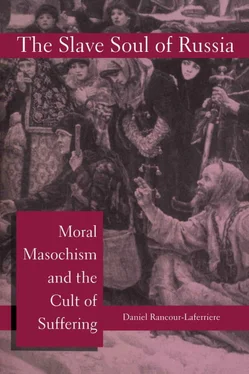The poor and suffering peasantry of Russia were, by their very misery, often thought to be perfect imitators of Christ (cf. the tradition of confusing “krest’ianin” [peasant] with “khristianin” [Christian]). 51To this day even not particularly religious Russians will, in a bad situation, utter the proverb: “Bog terpel, i nam velel” (“God [i.e., Christ] endured, and ordered us to [endure] too”). 52In suffering, a Russian is by definition imitating Christ.
Imitation of Christ is not some fuzzy, distant ideal for the religious Russian. It means concrete, physical and/or mental suffering. It can even entail a conscious search for humiliation. Dunlop says that starets Amvrosy “elected to spend his life hanging on a cross of self-abnegation.” 53The image of the cross is of course the Christian image par excellence . But here is a concrete example of just what that “cross” was for Amvrosy. The scene is the Optina Pustyn monastery in 1841, when Amvrosy was not yet a starets and was known as Alexander:
Once when… Alexander and Staretz Lev were together the Staretz suddenly intoned, “Blessed is our God, now and ever and unto ages of ages.” Alexander, thinking that the staretz desired to commence the evening rule began to chant, “Amen. Glory to Thee, O God, Glory to Thee. O Heavenly King….” Suddenly the staretz brought him up short, “Who gave you the blessing to read?” Alexander immediately fell down on his knees, prostrated himself and asked for forgiveness. The staretz, however, continued his tirade, “How dared you do that?” And Alexander continued his prostrations, murmuring, “Forgive me for the sake of God, Batiushka. Forgive me.” By fighting down the instinct of self-justification Alexander was able to crucify the “old man” in him and put on the new. 54
Such complete self-abnegation is the truest possible imitation of Christ.
Toward the end of his unhappy life the Russian writer Nikolai Vasil’evich Gogol (1809–52) became more and more attracted to religious self-abnegation. Christian humiliation became a goal for him. A great admirer of The Imitation of Christ , he gave advice such as the following to readers of his Selected Passages from Correspondence with Friends: “Pray to God… that someone should so disgrace you in the sight of others that you would not know where to hide yourself from shame…. That man would be your true brother and deliverer.” 55This advice Gogol applied to himself as well: “I myself also need a slap in public and, perhaps, more than anybody else.” 56
If a slap was what Gogol wanted, a slap is what he got, for even friends repudiated Gogol’s book which, among other things, pretended to give religious advice to the tsar, requested that everyone in Russia pray for him (Gogol), advocated flogging for both the offender and the victim, and claimed that the common folk were better off illiterate. The publication of Selected Passages was followed by further masochistic acts. For example, Gogol burned the manuscript of a book on which he had been working for five years, the second part of Dead Souls . He grew increasingly religious, visiting Optyna Pustyn on several occasions, and developing a close relationship with an Orthodox priest by the name of Matvei Konstantinovsky. The latter recommended fasting and incessant prayer. Gogol followed this advice with a vengeance, and as a result he died of starvation and exhaustion on February 10, 1852.
There is a rich and ever-changing terminology for the various forms of religious masochism in Russia. For example, in the Russian theological literature Christ’s voluntary relinquishment of divinity in order to experience human suffering is often termed “kenosis” (from the Greek, meaning “self-emptying”; cf. Philippians 2:6–8). The meaning of the term expands when scholars characterize the imitation of the self-humiliated Christ as “kenotic.” 57The meaning expands even further when, in her book The Humiliated Christ in Modern Russian Thought , Nadejda Gorodetzky says: “meekness, self-abasement, voluntary poverty, humility, obedience, ‘non-resistance,’ acceptance of suffering and death would be the expression of the ‘kenotic mood’.” 58Fedotov, although resisting the breadth of Gorodetzky’s conception, adds a spatial dimension: “It [kenoticism] is a downward movement of love, a descending, self-humiliating love, which finds its joy in being with the rejected.” 59Even Mikhail Bakhtin, whose dialogic theories would appear to have nothing to do with religion at all, gave kenoticism a central role. 60
Kenoticism, asceticism, monasticism, holy foolishness, self-immolation, self-flagellation, and self-castration are different, if somewhat overlapping religious practices. Each is worthy of in-depth psychoanalytic study in its own right. Although all share the property of moral masochism, other psychoanalytic properties are involved in varying degrees and combinations as well (such as paranoia, narcissism, exhibitionism, depression, and intellectualization), and each practice will fit slightly differently into the psychobiography of any given religious masochist.
Early Observers of Russian Masochism
Serfdom was one of the first social phenomena to be attacked by the fledgling Russian intelligentsia at the end of the eighteenth century. Berdiaev goes so far as to say that the intelligentsia “was born” when Aleksandr Radishchev (1749–1802) expressed his outrage over the cruel treatment of Russian serfs in A Journey from Petersburg to Moscow (1790). 61According to Radishchev, the peasant who works the field is the only one who has a real right to it, yet “with us, he who has the natural right to it is not only completely excluded from it, but, while working another’s field, sees his sustenance dependent on another’s power!” 62The enslavement of the Russian peasant not only provokes moral indignation in Radishchev, but induces him to make interesting psychological observations, such as the following:
It appears that the spirit of freedom is so dried up in the slaves that they not only have no desire to end their sufferings, but cannot bear to see others free. They love their fetters, if it is possible for man to love his own ruination. 63
Not only the literal slave, however, behaves slavishly. Members of the nobility can display extreme servility in their relations with others. Radishchev wonders whether those abused by a certain high dignitary know that
he is ashamed to admit to whom he owes his high station; that in his soul he is a most vile creature; that deception, perfidy, treason, lechery, poisoning, robbery, extortion and murder are no more to him than emptying a glass of water; that his cheeks have never blushed with shame, but often with anger or from a box on the ear; that he is a friend of every Court stoker and the slave [rab] of everybody, even the meanest creature, at Court? But he pretends to be a great lord and is contemptuous of those who are not aware of his base and crawling servility [nizkosti i polzushchestva]. 64
If the serf grows to love his chains, the nobleman wallows in servility. In both instances Radishchev identifies what appear, on their face at least, to be masochistic attitudes.
Poet Aleksandr Pushkin (1799–1837) reacted somewhat negatively to Radishchev’s characterization of the peasant’s plight in Russia. The French peasant, or the English factory worker is worse off, opines Pushkin in his 1834 essay on Radishchev’s Journey . This is doubtful, however, and in any case is irrelevant. At one point Pushkin declares: “Take a look at the Russian peasant: is there even the shadow of slavish degradation [ten’ rabskogo unichizheniia] in his behavior and speech?” 65This rhetorical question is followed by praise of the Russian peasant’s boldness, cleverness, imitativeness, generosity, etc.—none of which necessarily preclude slavishness at all. 66
Читать дальше












